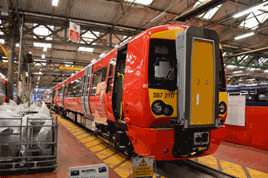The 501 new vehicles ordered for the Northern and TransPennine Express (TPE) franchises means that there are now more than 4,000 vehicles being built or on order for the UK.
And this is for the main line fleets - not the metro, where Transport for London is planning for the largest ever London Underground order and tram networks are expanding with new fleets being delivered.
It was November 27 last year - before the franchise orders were announced - that the Rail Delivery Group’s (RDG’s) new Chief Executive Paul Plummer highlighted how the industry is spending £9.3 billion on new trains and their maintenance contracts by the end of the decade.
Speaking at a rail industry gathering in Derby, Plummer said: “We know that fare payers want better trains, so this investment over the next four years is great news for our passengers. An average of 12 carriages per week are being built to meet demand - a far higher build rate than just a few years ago. More than half of the new trains are being built by British-based manufacturers, supporting more than 2,000 jobs including at least 100 apprenticeships.”
Of the fleets included in those figures, only three of the 11 ordered at that time were being delivered. It also did not include deals for new locomotives, for which six are due for GB Railfreight (Class 66s) and 25 for Direct Rail Services (Classes 68 and ‘88’).
Also not included were the additional vehicles for c2c, for which 17 four-car electric multiple units (EMUs) will be bought. Additionally, the Thameslink, Southern and Great Northern franchise (TSGN) appointed Siemens as preferred bidder for 150 carriages split across 25 trains (six-car trains) for its routes into Moorgate, to replace the ageing Class 313s that date from the electrification of Great Northern routes in 1976/77.
At the time Plummer spoke, at nearby Litchurch Lane Bombardier was completing the construction of the final Class 378 vehicles that would extend the London Overground electric multiple units from four to five-car trains.
The three fleets being delivered as Plummer spoke were the 108 Gatwick Express Class 387/2 vehicles, the 1,140 Class 700 vehicles for Govia Thameslink Railway and 866 Class 800/801 vehicles for Great Western Railway and Virgin Trains East Coast.
The latter two deals are the Thameslink and Intercity Express Programme (IEP) deals. Collectively these three deals are worth, including maintenance contracts, almost £7.5bn. All will be in traffic by the end of 2020 - indeed, this year the ‘387/2s’ and ‘700s’ will enter traffic while the first IEPs (or Super Express Train depending on the marketing) will enter traffic next year.
The new trains on order promise to transform the service quality of many routes, but many of the fleets they will replace are not destined for the scrapyard - instead they will go to other operators.
There is talk that some trains, such as the Class 442s, may end up in regions they have not been used in before as hauled stock, rather than powered EMUs.
But then there is also talk that some trains may also end up in fields, stored until a new home is found for them. Politically, the storage of trains at a time when capacity has become an issue is more of a hot potato than it was even a decade ago.
Some context is needed. At the start of privatisation, the railways were served by a mixed fleet. Diesel multiple units (DMUs) and EMUs had been delivered during the 1980s and 1990s as British Rail sought to move to a railway dominated by fixed formation trains. This trend continued in the privatisation era, when the need to replace the BR fleets from the 1950s and 1960s was needed. That meant that during the late-2000s, the railway had a young fleet but many of these types were reaching the halfway point of their careers.
The vehicles ordered that broke the infamous 1,064-day train order drought are now 17 years old (Class 168 Clubmans used by Chiltern Railways). The South West Trains Class 458s were the first electric trains delivered following privatisation, and these are now 17 years old. The c2c Class 357 and Southeastern Class 375 Electrostars date from 1999, while the Class 170 DMUs were first delivered to the Midland Main Line in 1998. Even Virgin Trains’ Class 390 Pendolino fleet first entered traffic in 2002, the same year that SWT’s Desiro fleet was launched.
These trains still seem new - and certainly compared with the Pacers used by Arriva Trains Wales (as well as in the North) and the EMUs operated by Merseyrail, they are - but they have been in use longer than some people realise.
This means that the average age of rolling stock nationally at the end of 2014-15 was 20.2 years, according to data released in October 2015 by the Office of Rail and Road (RAIL 787).
The average age of rolling stock fell across all sectors following the start of the time series, and nationally the average age of rolling stock fell 7.7 years between 2001-02 Q2 and 2005-06 Q2. The ORR says this was due to the rolling stock leasing companies (ROSCOs) replacing many of the BR fleets with new trains (2005 was the last year of Mk 1 slam-door trains on the former Southern Region, for example). After 2005-06 Q2 the average age of rolling stock increased for all sectors.
Nationally the average age of rolling stock has increased by 0.8 years between 2013-14 Q4 and 2014-15 Q4. This means newer rolling stock was introduced or older rolling stock removed from service during 2014-15. This was driven by newer rolling stock within the London and South East sector.
Following up Plummer’s quotes on November 27 last year, Rail Minister Claire Perry said: “Introducing more modern, high-quality trains is central to our commitment to give passengers better journeys and boost economic growth.
















Login to comment
Comments
No comments have been made yet.